Straw Incorporation Management Affects Maize Grain Yield through Regulating Nitrogen Uptake, Water Use Efficiency, and Root Distribution
Abstract
1. Introduction
2. Materials and Methods
2.1. Site Description
2.2. Experimental Design
2.3. Sampling and Measurements
2.4. Calculations
2.5. Statistical Analysis
3. Results
3.1. Soil Mineral N Storage and Water Use Efficiency
3.2. Root Traits
3.3. Shoot N Uptake Pre- and Post-Silking
3.4. Grain Yield
3.5. Direct and Indirect Impacts of Tillage with Straw Incorporation and N Rate Induced Factors on Maize Grain Yield
4. Discussion
4.1. Soil Water and Mineral N Storage
4.2. Root Distribution and N Uptake
4.3. Grain Yield and Water Use Efficiency
4.4. The Potential Mechanism of Maize Grain Yield Response to Tillage with Straw Incorporation Management and N Levels
5. Conclusions
Author Contributions
Funding
Conflicts of Interest
References
- Wang, S.; Zhang, C. Spatial and temporal distribution of air pollutant emissions from open burning of crop residues in China. Sci. Online 2008, 3, 329–333. [Google Scholar]
- Li, H.; Cao, Y.; Wang, X.M.; Ge, X.; Li, B.Q.; Jin, C.Q. Evaluation on the production of food crop straw in China from 2006 to 2014. BioEnergy Res. 2017, 10, 949–957. [Google Scholar] [CrossRef]
- Zhang, J.; Hang, X.; Lamine, S.M.; Jiang, Y.; Afreh, D.; Qian, H.; Feng, X.; Zheng, C.; Deng, A.; Song, Z.; et al. Interactive effects of straw incorporation and tillage on crop yield and greenhouse gas emissions in double rice cropping system. Agric. Ecosyst. Environ. 2017, 250, 37–43. [Google Scholar] [CrossRef]
- Qu, C.; Li, B.; Wu, H.; Giesy, J.P. Controlling air pollution from straw burning in China calls for efficient recycling. Environ. Sci. Technol. 2012, 46, 7934–7936. [Google Scholar] [CrossRef]
- Turmel, M.S.; Speratti, A.; Baudron, F.; Verhulst, N.; Govaerts, B. Crop residue management and soil health: A systems analysis. Agric. Syst. 2015, 134, 6–16. [Google Scholar] [CrossRef]
- Li, H.; Dai, M.W.; Dai, S.L.; Dong, X.J. Current status and environment impact of direct straw return in China’s cropland—A review. Ecotox. Environ. Saf. 2018, 159, 293–300. [Google Scholar] [CrossRef]
- Yin, H.J.; Zhao, W.Q.; Li, T.; Cheng, X.Y.; Liu, Q. Balancing straw returning and chemical fertilizers in China: Role of straw nutrient resources. Renew. Sustain. Energy Rev. 2018, 81, 2695–2702. [Google Scholar] [CrossRef]
- Kuzyakov, Y.; Xu, X.L. Competition between roots and microorganisms for nitrogen: Mechanisms and ecological relevance. New Phytol. 2013, 198, 656–669. [Google Scholar] [CrossRef]
- Li, X.G.; Jia, B.; Lv, J.T.; Ma, Q.J.; Kuzyakov, Y.; Li, F.M. Nitrogen fertilization decreases the decomposition of soil organic matter and plant residues in planted soils. Soil Biol. Biochem. 2017, 112, 47–55. [Google Scholar] [CrossRef]
- Hou, P.; Gao, Q.; Xie, R.Z.; Li, S.K.; Meng, Q.F.; Kirkby, E.A.; Römheld, V.; Müller, T.; Zhang, F.S.; Cui, Z.L.; et al. Grain yields in relation to N requirement: Optimizing nitrogen management for spring maize grown in China. Field Crop. Res. 2012, 129, 1–6. [Google Scholar] [CrossRef]
- Guan, D.; Zhang, Y.; Al-Kaisi, M.M.; Wang, Q.; Zhang, M.; Li, Z. Tillage practices effect on root distribution and water use efficiency of winter wheat under rain–fed condition in the North China Plain. Soil Tillage Res. 2015, 146, 286–295. [Google Scholar] [CrossRef]
- Bolaños, J.; Edmeades, G.O. The importance of the anthesis–silking interval in breeding for drought tolerance in tropical maize. Field Crop. Res. 1996, 48, 65–80. [Google Scholar] [CrossRef]
- Mu, X.Y.; Zhao, Y.L.; Liu, K.; Ji, B.Y.; Guo, H.B.; Xue, Z.W.; Li, C.H. Responses of soil properties, root growth and crop yield to tillage and crop residue management in a wheat–maize cropping system on the North China Plain. Eur. J. Agron. 2016, 78, 32–43. [Google Scholar] [CrossRef]
- Mosaddeghi, M.R.; Mahboubi, A.A.; Safadoust, A. Short–term effects of tillage and manure on some soil physical properties and maize root growth in a sandy loam soil in western Iran. Soil Tillage Res. 2009, 104, 173–179. [Google Scholar] [CrossRef]
- Laddha, K.C.; Totawat, K.L. Effects of deep tillage under rainfed agriculture on production of sorghum (Sorghum biocolor L. Moench) intercropped with green gram (Vigna radiata L. Wilczek) in western India. Soil Tillage Res. 1997, 43, 241–250. [Google Scholar] [CrossRef]
- Berhe, F.T.; Fanta, A.; Alamirew, T.; Melesse, A.M. The effect of tillage practices on grain yield and water use efficiency. Catena 2012, 100, 128–138. [Google Scholar] [CrossRef]
- Cai, H.G.; Ma, W.; Zhang, X.Z.; Ping, J.Q.; Yan, X.G.; Liu, J.Z.; Yuan, J.C.; Wang, L.C.; Ren, J. Effect of subsoil tillage depth on nutrient accumulation, root distribution, and grain yield in spring maize. Crop. J. 2014, 2, 297–307. [Google Scholar] [CrossRef]
- Guan, D.H.; Al-Kaisi, M.M.; Zhang, Y.S.; Duan, L.S.; Tan, W.M.; Zhang, M.C.; Li, Z.H. Tillage practices affect biomass and grain yield through regulating root growth, root–bleeding sap and nutrients uptake in summer maize. Field Crop. Res. 2014, 157, 89–97. [Google Scholar] [CrossRef]
- Chen, X.C.; Zhang, J.; Chen, Y.L.; Li, Q.; Chen, F.J.; Yuan, L.X.; Mi, G.H. Changes in root size and distribution in relation to nitrogen accumulation during maize breeding in China. Plant. Soil 2013, 374, 121–130. [Google Scholar] [CrossRef]
- Li, C.S.; Li, J.G.; Tang, Y.L.; Wu, X.L.; Wu, C.; Huang, G.; Zeng, H. Stand establishment, root development and yield of winter wheat as affected by tillage and straw mulch in the water deficit hilly region of southwestern China. J. Integr. Agric. 2016, 15, 1480–1489. [Google Scholar] [CrossRef]
- Xu, X.; Pang, D.W.; Chen, J.; Luo, Y.L.; Zheng, M.J.; Yin, Y.P.; Li, Y.X.; Li, Y.; Wang, Z.L. Straw return accompany with low nitrogen moderately promoted deep root. Field Crop. Res. 2018, 221, 71–80. [Google Scholar] [CrossRef]
- Svoboda, P.; Haberle, J. The effect of nitrogen fertilization on root distribution of winter wheat. Plant. Soil Environ. 2006, 52, 308–313. [Google Scholar] [CrossRef]
- Feng, G.Z.; Zhang, Y.J.; Chen, Y.L.; Li, Q.; Chen, F.J.; Gao, Q.; Mi, G.H. Effects of nitrogen application on root length and grain yield of rain–fed maize under different soil types. Agron. J. 2016, 108, 1656. [Google Scholar] [CrossRef]
- Pedersen, A.; Zhang, K.; Thorup-Kristensen, K.; Jensen, L.S. Modelling diverse root density dynamics and deep nitrogen uptake–A simple approach. Plant. Soil 2009, 326, 493–510. [Google Scholar] [CrossRef]
- Trachsel, S.; Kaeppler, S.M.; Brown, K.M.; Lynch, J.P. Maize root growth angles become steeper under low N conditions. Field Crop. Res. 2013, 140, 18–31. [Google Scholar] [CrossRef]
- Thorup-Kristensen, K.; Salmerón, C.M.; Loges, R. Winter wheat roots grow twice as deep as spring wheat roots, is this important for N uptake and N leaching losses? Plant. Soil 2009, 322, 101–114. [Google Scholar] [CrossRef]
- Lynch, J.P. Steep, cheap and deep: An ideotype to optimize water and N acquisition by maize root systems. Ann. Bot. 2013, 112, 347–357. [Google Scholar] [CrossRef]
- Peng, Y.F.; Niu, J.F.; Peng, Z.P.; Zhang, F.S.; Li, C.J. Shoot growth potential drives N uptake in maize plants and correlates with root growth in the soil. Field Crop. Res. 2010, 115, 85–93. [Google Scholar] [CrossRef]
- Yan, H.F.; Shang, A.X.; Peng, Y.F.; Yu, P.; Li, C.J. Covering middle leaves and ears reveals differential regulatory roles of vegetative and reproductive organs in root growth and nitrogen uptake in maize. Crop. Sci. 2011, 51, 265–272. [Google Scholar] [CrossRef]
- Ogawa, A.; Kawashima, C.; Yamauchi, A. Sugar accumulation along the seminal root axis, as affected by osmotic stress in maize: A possible physiological basis for plastic lateral root development. Plant. Prod. Sci. 2015, 8, 173–180. [Google Scholar] [CrossRef][Green Version]
- Hirel, B.; Le Gouis, J.; Ney, B.; Gallais, A. The challenge of improving nitrogen use efficiency in crop plants: Towards a more central role for genetic variability and quantitative genetics within integrated approaches. J. Exp. Bot. 2007, 58, 2369–2387. [Google Scholar] [CrossRef] [PubMed]
- Niu, J.F.; Peng, Y.F.; Li, C.J.; Zhang, F.S. Changes in root length at the reproductive stage of maize plants grown in the field and quartz sand. J. Plant. Nutr. Soil Sci. 2010, 173, 306–314. [Google Scholar] [CrossRef]
- Gallais, A.; Coque, M. Genetic variation and selection for nitrogen use efficiency in maize: A synthesis. Maydica 2005, 50, 531–537. [Google Scholar]
- Gao, K.; Chen, F.J.; Yuan, L.X.; Zhang, F.S.; Mi, G.H. A comprehensive analysis of root morphological changes and nitrogen allocation in maize in response to low nitrogen stress. Plant. Cell Environ. 2015, 38, 740–750. [Google Scholar] [CrossRef]
- Blake, G.; Hartage, K. Methods of Soil Analysis, Part. 1; Macmillan: New York, NY, USA, 1986. [Google Scholar]
- Joseph, G.; Henry, H.A.L. Soil nitrogen leaching losses in response to freeze–thaw cycles and pulsed warming in a temperate old field. Soil Biol. Biochem. 2008, 40, 1947–1953. [Google Scholar] [CrossRef]
- Dong, Q.G.; Yang, Y.C.; Yu, K.; Feng, H. Effects of straw mulching and plastic film mulching on improving soil organic carbon and nitrogen fractions, crop yield and water use efficiency in the Loess Plateau, China. Agric. Water Manag. 2018, 201, 133–143. [Google Scholar] [CrossRef]
- Nelson, D.W.; Somers, L.E. Determination of total nitrogen in plant material. Agron. J. 1973, 65, 109–112. [Google Scholar] [CrossRef]
- Wang, T.C.; Wei, L.; Wang, H.Z.; Ma, S.C.; Ma, B.L. Responses of rainwater conservation, precipitation–use efficiency and grain yield of summer maize to a furrow–planting and straw–mulching system in northern China. Field Crop. Res. 2011, 124, 223–230. [Google Scholar] [CrossRef]
- Dal Ferro, N.; Sartori, L.; Simonetti, G.; Berti, A.; Morari, F. Soil macro–and microstructure as affected by different tillage systems and their effects on maize root growth. Soil Tillage Res. 2014, 140, 55–65. [Google Scholar] [CrossRef]
- Malhi, S.S.; Nyborg, M.; Solberg, E.D.; McConkey, B.; Dyck, M.; Puurveen, D. Long–term straw management and N fertilizer rate effects on quantity and quality of organic C and N and some chemical properties in two contrasting soils in Western Canada. Biol. Fert. Soils 2011, 47, 785–800. [Google Scholar] [CrossRef]
- Yadvinder, S.; Gupta, R.K.; Jagmohan, S.; Gurpreet, S.; Gobinder, S.; Ladha, J.K. Placement effects on rice residue decomposition and nutrient dynamics on two soil types during wheat cropping in rice–wheat system in northwestern India. Nutr. Cycl. Agroecosys. 2010, 88, 471–480. [Google Scholar] [CrossRef]
- Meek, B.D.; Carter, D.L.; Westermann, D.T.; Wright, J.L.; Peckenpaugh, R.E. Nitrate leaching under furrow irrigation as affected by crop sequence and tillage. Sci. Soc. Am. J. 1995, 59, 204–210. [Google Scholar] [CrossRef]
- You, D.B.; Tian, P.; Sui, P.X.; Zhang, W.K.; Yang, B.; Qi, H. Short–term effects of tillage and residue on spring maize yield through regulating root–shoot ratio in Northeast China. Sci. Rep. 2017, 7, 13314. [Google Scholar] [CrossRef] [PubMed]
- Ren, B.Z.; Li, X.; Dong, S.T.; Liu, P.; Zhao, B.; Zhang, J.W. Soil physical properties and maize root growth under different tillage systems in the North China Plain. Crop. J. 2018, 6, 669–676. [Google Scholar] [CrossRef]
- Schneider, F.; Don, A.; Hennings, I.; Schmittmann, O.; Seidel, S.J. The effect of deep tillage on crop yield—What do we really know? Soil Tillage Res. 2017, 174, 193–204. [Google Scholar] [CrossRef]
- Brennan, J.; Hackett, R.; McCabe, T.; Grant, J.; Fortune, R.A.; Forristal, P.D. The effect of tillage system and residue management on grain yield and nitrogen use efficiency in winter wheat in a cool Atlantic climate. Eur. J. Agron. 2014, 54, 61–69. [Google Scholar] [CrossRef]
- Chen, Y.L.; Xiao, C.X.; Wu, D.L.; Xia, T.T.; Chen, Q.W.; Chen, F.J.; Yuan, L.X.; Mi, G.H. Effects of nitrogen application rate on grain yield and grain nitrogen concentration in two maize hybrids with contrasting nitrogen remobilization efficiency. Eur. J. Agron. 2015, 62, 79–89. [Google Scholar] [CrossRef]
- Shi, Z.L.; Jing, Q.; Cai, J.; Jiang, D.; Cao, W.X.; Dai, T.B. The fates of 15N fertilizer in relation to root distributions of winter wheat under different N splits. Eur. J. Agron. 2012, 40, 86–93. [Google Scholar] [CrossRef]
- Gallais, A.; Coque, M.; Le Gouis, J.; Prioul, J.L.; Hirel, B.; Quilléré, I. Estimating the proportion of nitrogen remobilization and of postsilking nitrogen uptake allocated to maize kernels by nitrogen–15 labeling. Crop. Sci. 2007, 47, 685. [Google Scholar] [CrossRef]

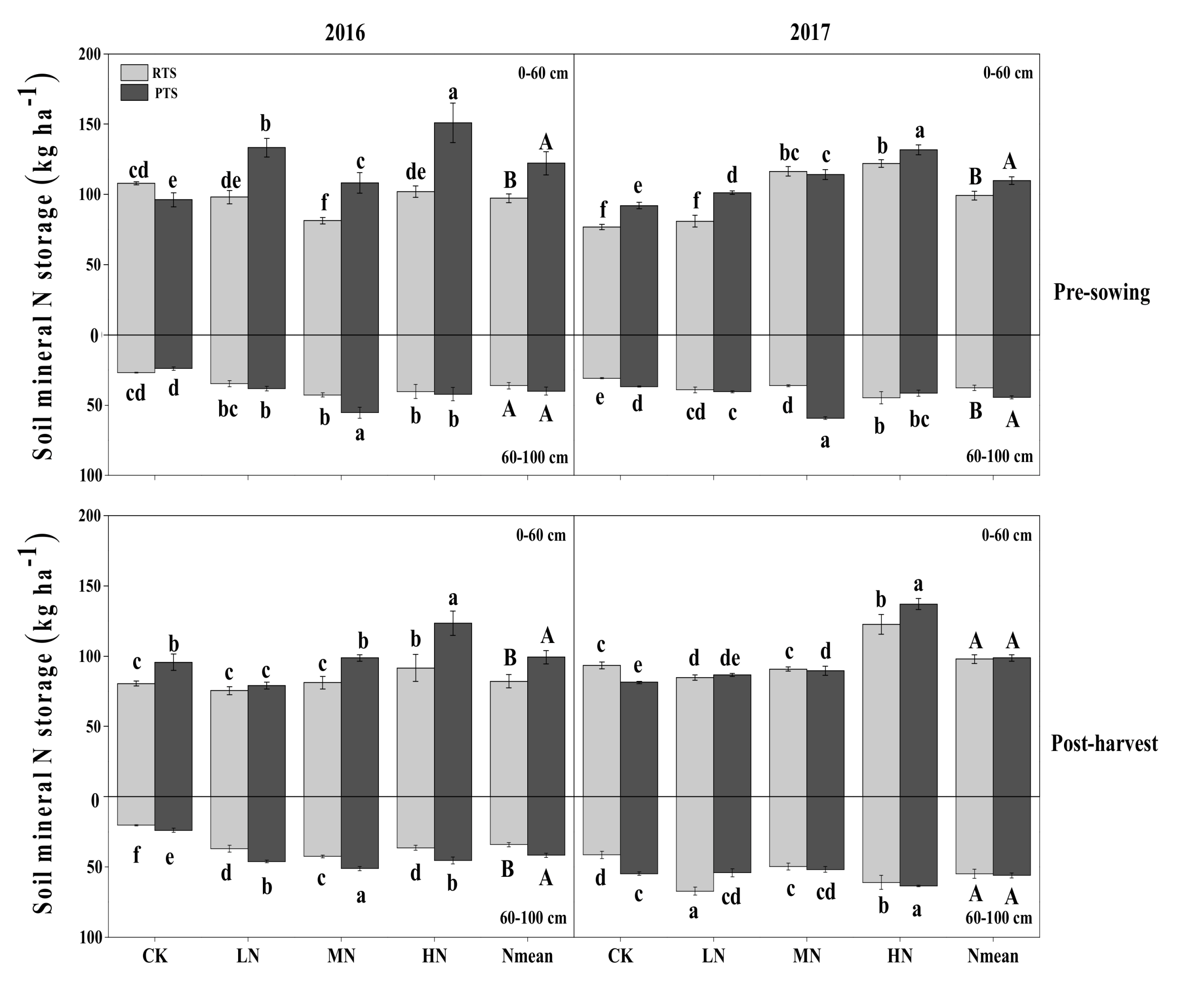
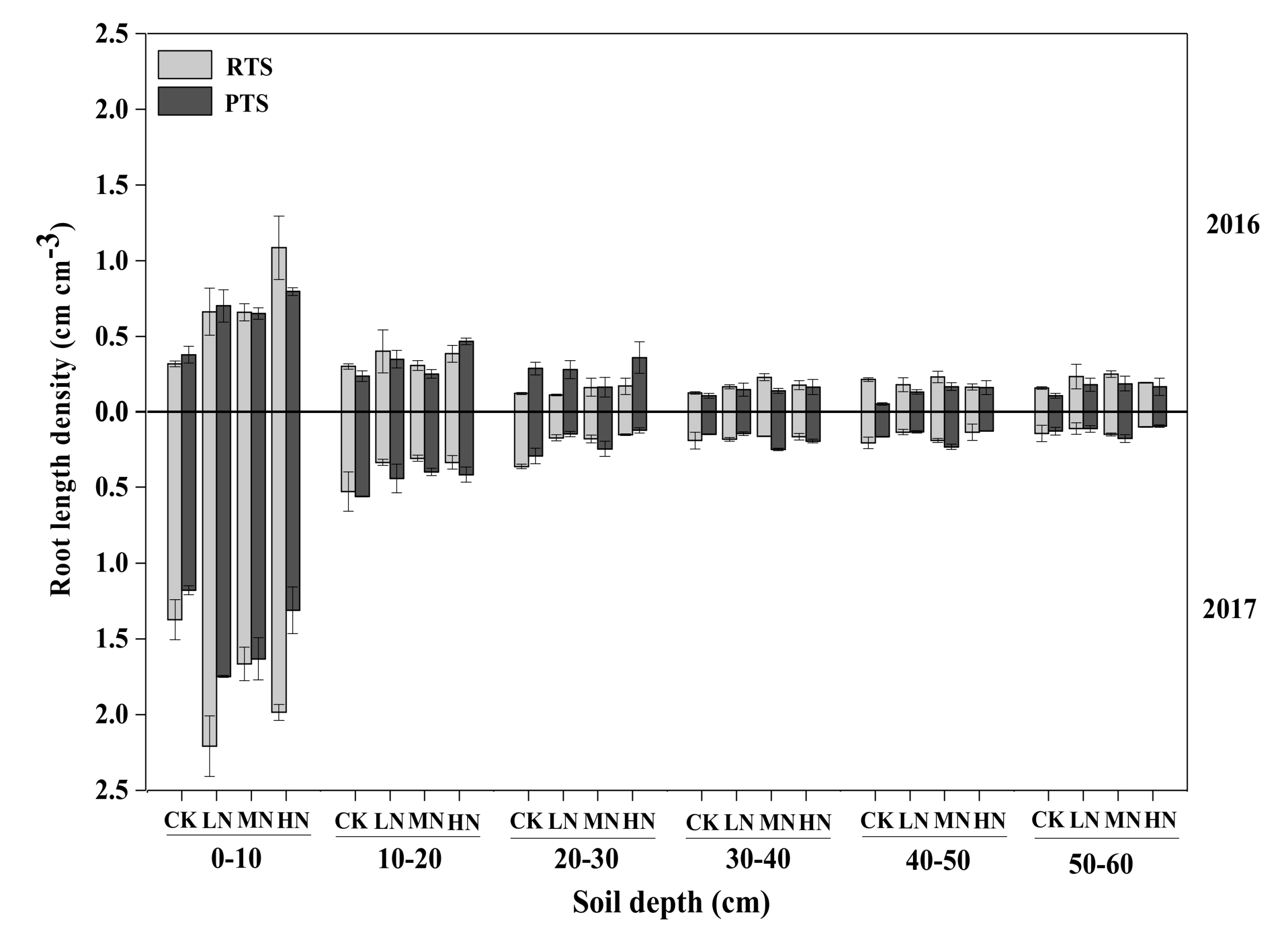
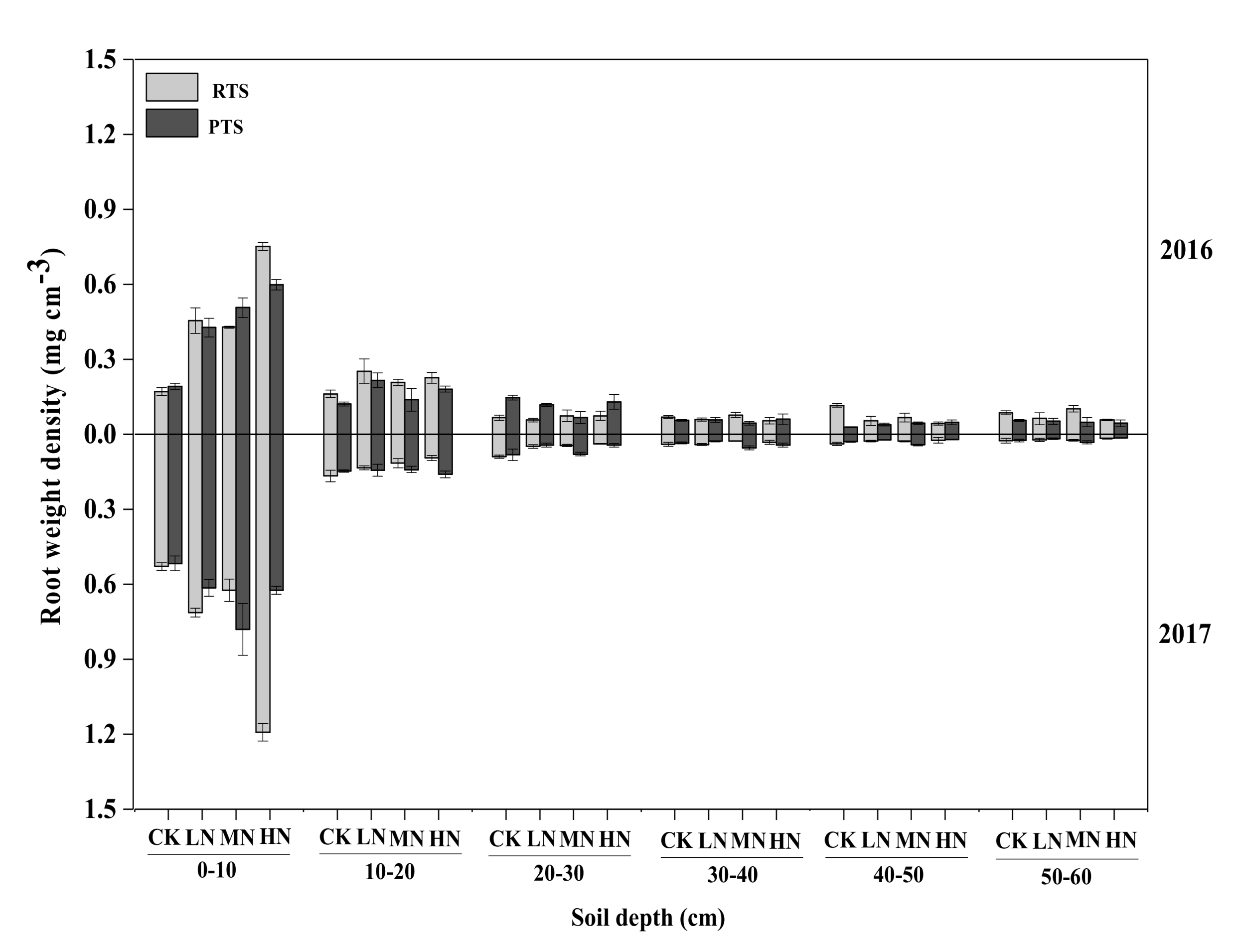

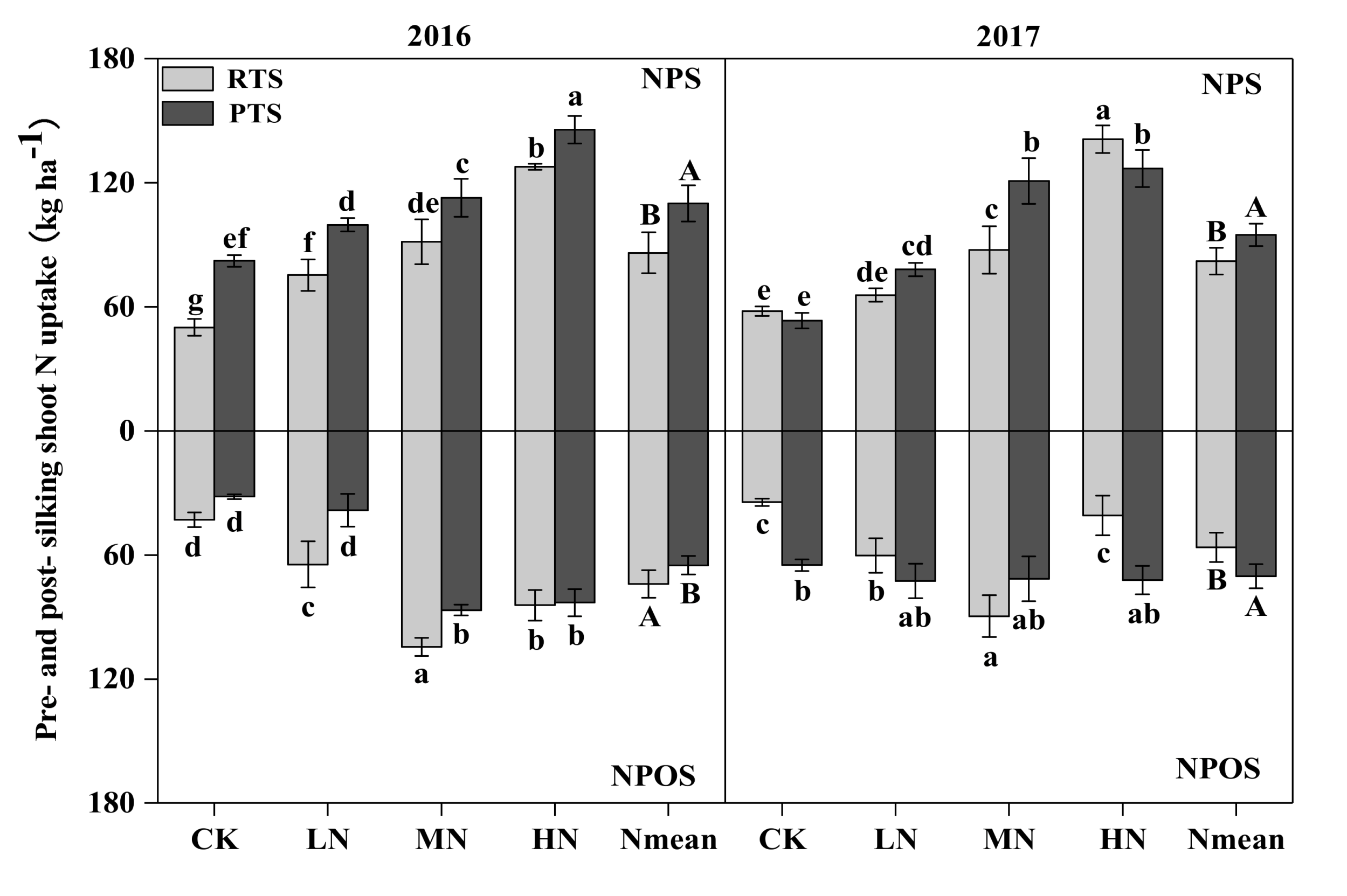
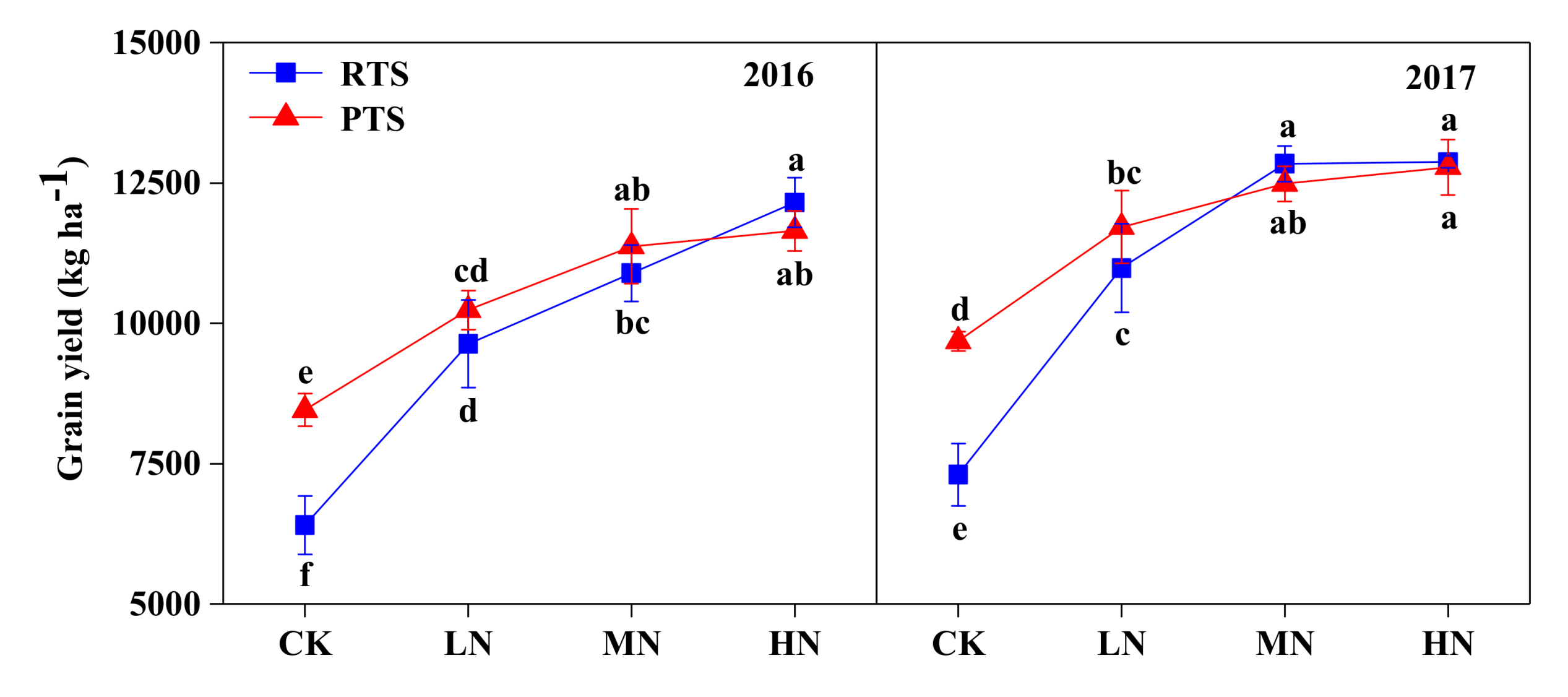
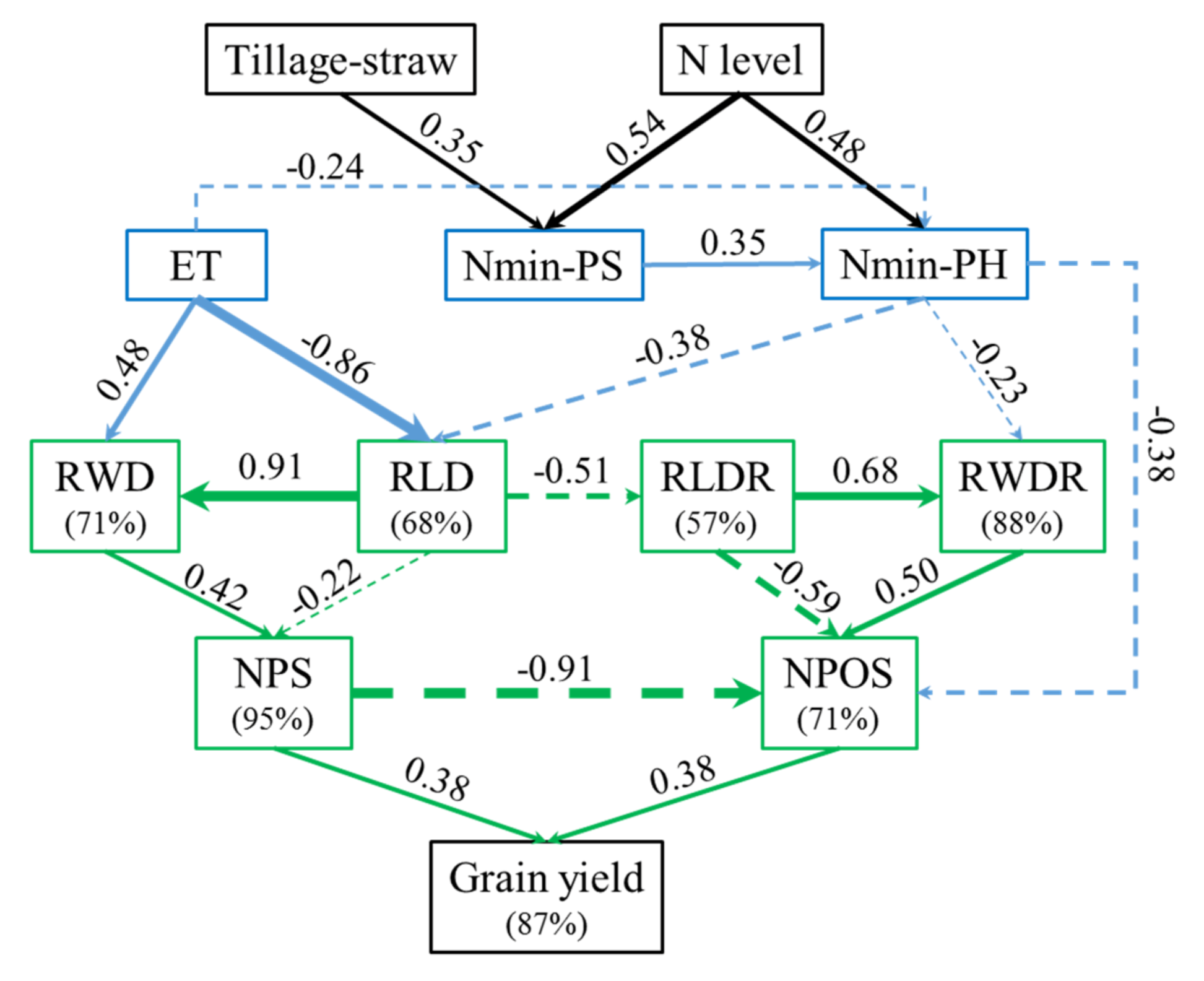
| Source of Variation | Soil Mineral N Storage (kg N ha−1) | Root Growth | Shoot N Uptake (kg N ha−1) | Grain Yield (kg ha−1) | |||||
|---|---|---|---|---|---|---|---|---|---|
| Pre-Sowing | Post-Harvest | RLD (cm cm−3) | RWD (mg cm−3) | RLDR (%) | RWDR (%) | Pre-Silking Shoot N Uptake (NPS) | Post-Silking Shoot N Uptake (NPOS) | ||
| Tillage with straw incorporation (Ts) | 228.1 *** | 75.9 *** | 12.2 ** | 28.2 *** | 16.0 *** | 16.3 *** | 60.5 *** | 0.1 ns | 14.9 *** |
| N level (N) | 140.0 *** | 182.1 *** | 27.4 *** | 36.1 *** | 24.4 *** | 64.0 *** | 265.6 *** | 59.7 *** | 174.3 *** |
| Year (Y) | 26.5 *** | 273.5 *** | 480.8 *** | 38.6 *** | 514.6 *** | 481.7 *** | 11.6 ** | 2.4 ns | 96.9 *** |
| Ts × N | 36.0 *** | 15.0 *** | 2.1 ns | 10.1 *** | 14.5 *** | 17.2 *** | 7.2 ** | 9.7 *** | 13.5 *** |
| Ts × Y | 48.3 *** | 54.4 *** | 5.5 * | 0.4 ns | 40.3 *** | 32.5 *** | 19.0 ** | 33.3 *** | 0.1 ns |
| Ns × Y | 46.0 *** | 28.6 *** | 18.3 *** | 7.4 *** | 5.7 * | 20.6 *** | 4.0 * | 18.1 *** | 0.8 ns |
| Ts × N × Y | 39.0 *** | 0.5 ns | 5.0 ** | 7.6 *** | 6.2 ** | 10.7 *** | 8.0 *** | 3.9 * | 0.8 ns |
| Treatment | Pre-Sowing Soil Water Storage (mm) | Post-Harvest Soil Water Storage (mm) | ET (mm) | WUE (kg mm−1 ha−1) | |||||
|---|---|---|---|---|---|---|---|---|---|
| RTS | PTS | RTS | PTS | RTS | PTS | RTS | PTS | ||
| 2016 | CK | 221a | 214b | 585cd | 587bcd | 448ab | 438cd | 14.3e | 19.5d |
| LN | 220a | 216b | 589abc | 582d | 442bc | 445b | 21.8c | 23.2bc | |
| MN | 223a | 212b | 582d | 593a | 452a | 430e | 24.1b | 26.6a | |
| HN | 223a | 214b | 590abc | 592ab | 444b | 434de | 27.4a | 27.0a | |
| Nmean | 222A | 214B | 587A | 588A | 446A | 437B | 21.9B | 24.1A | |
| 2017 | CK | 266b | 257b | 274a | 270a | 326d | 321e | 22.4c | 30.2b |
| LN | 272a | 257b | 259c | 262bc | 346a | 329d | 31.8b | 35.6a | |
| MN | 270a | 260b | 265b | 255d | 339b | 339b | 37.9a | 36.9a | |
| HN | 269a | 260b | 259cd | 260c | 345a | 334c | 37.4a | 38.3a | |
| Nmean | 269A | 259B | 264A | 262A | 339A | 330B | 32.4B | 35.2A | |
| F-value | |||||||||
| Tillage with straw incorporation (Ts) | 119.4 *** | 0.1 ns | 98.7 *** | 37.2 *** | |||||
| N level (N) | 2.2 ns | 10.9 *** | 24.3 *** | 165.6 *** | |||||
| Year (Y) | 4560.2 *** | 169036.5 *** | 24021.5 *** | 838.2 *** | |||||
| Ts × N | 0.7 ns | 1.0 ns | 2.4 ns | 13.9 *** | |||||
| Ts × Y | 24.2 *** | 5.9 * | 4.0 ns | 2.2 ns | |||||
| N × Y | 1.4 ns | 21.7 *** | 37.8 *** | 2.2 ns | |||||
| Ts × N × Y | 4.2 * | 16.2 *** | 38.1 *** | 3.5 * | |||||
© 2020 by the authors. Licensee MDPI, Basel, Switzerland. This article is an open access article distributed under the terms and conditions of the Creative Commons Attribution (CC BY) license (http://creativecommons.org/licenses/by/4.0/).
Share and Cite
Sui, P.; Tian, P.; Lian, H.; Wang, Z.; Ma, Z.; Qi, H.; Mei, N.; Sun, Y.; Wang, Y.; Su, Y.; et al. Straw Incorporation Management Affects Maize Grain Yield through Regulating Nitrogen Uptake, Water Use Efficiency, and Root Distribution. Agronomy 2020, 10, 324. https://doi.org/10.3390/agronomy10030324
Sui P, Tian P, Lian H, Wang Z, Ma Z, Qi H, Mei N, Sun Y, Wang Y, Su Y, et al. Straw Incorporation Management Affects Maize Grain Yield through Regulating Nitrogen Uptake, Water Use Efficiency, and Root Distribution. Agronomy. 2020; 10(3):324. https://doi.org/10.3390/agronomy10030324
Chicago/Turabian StyleSui, Pengxiang, Ping Tian, Hongli Lian, Zhengyu Wang, Ziqi Ma, Hua Qi, Nan Mei, Yue Sun, Yingyan Wang, Yehan Su, and et al. 2020. "Straw Incorporation Management Affects Maize Grain Yield through Regulating Nitrogen Uptake, Water Use Efficiency, and Root Distribution" Agronomy 10, no. 3: 324. https://doi.org/10.3390/agronomy10030324
APA StyleSui, P., Tian, P., Lian, H., Wang, Z., Ma, Z., Qi, H., Mei, N., Sun, Y., Wang, Y., Su, Y., Meng, G., & Jiang, Y. (2020). Straw Incorporation Management Affects Maize Grain Yield through Regulating Nitrogen Uptake, Water Use Efficiency, and Root Distribution. Agronomy, 10(3), 324. https://doi.org/10.3390/agronomy10030324





